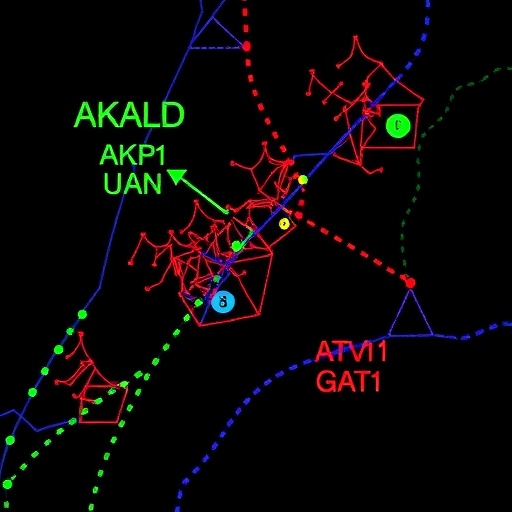In a groundbreaking advancement poised to reshape our understanding of metabolic associated steatotic liver disease (MASLD), researchers have uncovered a pivotal molecular mechanism that could open novel therapeutic avenues for this increasingly prevalent condition. The study, led by He, L., She, X., and Guo, L. among others, identified that a deficiency of A-kinase anchoring protein 1 (AKAP1) in the liver significantly exacerbates diet-induced MASLD by amplifying the activity of glycerol-3-phosphate acyltransferase 1 (GPAT1), a key enzyme driving the synthesis of lysophosphatidic acid (LPA). Published in Nature Communications, this research marks a critical milestone in decoding the complex biochemical cascades underlying MASLD and its progression.
MASLD, often synonymous with fatty liver disease related to metabolic dysfunction, is rapidly emerging as a global health concern linked to obesity, insulin resistance, and altered lipid metabolism. At its core, the disease manifests through excessive lipid accumulation in hepatocytes, leading to inflammation, fibrosis, and ultimately hepatic dysfunction. Despite increasing incidences, the molecular events governing MASLD development remain only partially elucidated, hindering precise targeted treatment strategies. This newly reported AKAP1-GPAT1-LPA axis sheds light on a novel mechanistic axis integral to this pathological process.
AKAP1 is an anchoring protein traditionally recognized for positioning protein kinase A (PKA) at specific mitochondrial locales, thereby influencing mitochondrial dynamics and energy homeostasis. The study’s findings suggest that AKAP1 plays an even broader role in hepatic lipid metabolism. AKAP1 deficiency in the liver not only dampens mitochondrial regulatory functions but also triggers an aberrant upregulation of GPAT1. GPAT1 is the rate-limiting enzyme catalyzing the initial step in glycerolipid biosynthesis, converting glycerol-3-phosphate to lysophosphatidic acid—a lipid intermediate that profoundly impacts cell signaling and membrane synthesis.
The pathological consequence of AKAP1 loss emerges from the consequent increase in GPAT1-mediated LPA synthesis. Lysophosphatidic acid is a bioactive lipid known for its capacity to modulate multiple signaling pathways including those involved in inflammation, fibrosis, and cellular proliferation. Enhanced hepatic LPA production disrupts normal metabolic signaling, contributing to the accumulation of triglycerides and the propagation of inflammatory cascades, both hallmark features of MASLD progression. This discovery potentially identifies hepatic LPA as a critical bioactive mediator linking metabolic perturbations to liver injury.
Key experiments in the study utilized genetically engineered mouse models with liver-specific deletion of AKAP1. When subjected to a diet high in fat and sugar—mimicking Western dietary habits—the AKAP1-deficient mice exhibited a pronounced worsening of liver steatosis compared to wild-type controls. Histological examination showed extensive lipid droplet accumulation and increased markers of hepatic inflammation and fibrosis. Moreover, comprehensive lipidomic analyses confirmed elevated levels of LPA species in liver tissues, corroborating the proposed pathogenic mechanism.
The researchers also investigated the regulatory relationship between AKAP1 and GPAT1 expression. Their data indicated that AKAP1 modulates mitochondrial signaling pathways that indirectly restrain GPAT1 enzyme activity. Loss of AKAP1 removes this regulatory checkpoint, unleashing unrestrained GPAT1 function and thereby boosting LPA biosynthesis. This insight invites further exploration into mitochondrial-nuclear crosstalk as a potential modulator of lipid metabolic enzymes and highlights mitochondrial integrity as a therapeutic focus.
Furthermore, the study demonstrated that pharmacological inhibition of GPAT1 could partially reverse the deleterious effects of AKAP1 deficiency. Treatment with GPAT1-specific inhibitors reduced hepatic LPA levels, decreased triglyceride accumulation, and attenuated inflammatory responses in the liver. These results, albeit preliminary, suggest a promising therapeutic strategy targeting the GPAT1-LPA axis to mitigate diet-induced MASLD—especially in individuals exhibiting compromised mitochondrial regulation.
Beyond immediate therapeutic implications, the findings elevate the significance of lysophosphatidic acid as a potential biomarker for MASLD severity and progression. Circulating or hepatic LPA measurement could provide clinicians with a novel tool to stratify patient risk and monitor treatment responses. This would represent a paradigm shift from purely morphological diagnosis based on liver biopsy or imaging toward a molecularly informed approach, enhancing precision in clinical management.
Interestingly, AKAP1’s role in other organs—particularly in cardiovascular and neurological tissues—has been well characterized, but its hepatic function remained largely unexplored until now. This study not only elucidates a previously unrecognized liver-specific function of AKAP1 but also bridges mitochondrial signaling with lipid metabolic regulation, uniting two traditionally distinct fields. It paves the way for integrative studies assessing systemic effects of AKAP1 deficiency and potential cross-talk between liver and other metabolically active tissues.
From a public health perspective, the research underscores the exacerbating effect of unhealthy diets on preexisting molecular vulnerabilities such as AKAP1 deficiency. As the global burden of metabolic syndrome-related liver diseases continues to escalate, understanding gene-environment interactions becomes increasingly critical. Identification of patients with compromised AKAP1 function may enable personalized dietary recommendations and early pharmacological interventions to preempt MASLD onset or progression.
The study’s comprehensive approach—encompassing genomics, metabolomics, and murine disease models—provides robust evidence for the centrality of the AKAP1-GPAT1-LPA axis in MASLD pathogenesis. However, translation of these findings into human clinical settings will require extensive validation. Delineating potential genetic variants in the human AKAP1 gene that predispose individuals to impaired hepatic function or altered lipid metabolism could greatly inform risk assessment strategies.
Moreover, the interplay between AKAP1 deficiency and other known contributors to MASLD such as insulin resistance, oxidative stress, and gut microbiome alterations remains to be fully defined. Multifactorial modeling incorporating AKAP1’s influence could broaden therapeutic horizons and inspire combination treatments targeting multiple pathogenic nodes simultaneously.
Subject of Research: Hepatic mechanisms underlying diet-induced metabolic associated steatotic liver disease (MASLD) focusing on AKAP1 deficiency and GPAT1-mediated lysophosphatidic acid synthesis.
Article Title: Hepatic AKAP1 deficiency exacerbates diet-induced MASLD by enhancing GPAT1-mediated lysophosphatidic acid synthesis.
Article References: He, L., She, X., Guo, L. et al. Hepatic AKAP1 deficiency exacerbates diet-induced MASLD by enhancing GPAT1-mediated lysophosphatidic acid synthesis. Nat Commun 16, 4286 (2025). https://doi.org/10.1038/s41467-025-58790-7
Image Credits: AI Generated
Tags: A-kinase anchoring protein researchAKAP1 loss and MASLDGPAT1 activation mechanismlipid metabolism in liver diseaseliver disease and obesity connectionliver inflammation and fibrosislysophosphatidic acid synthesismetabolic associated steatotic liver diseasemetabolic dysfunction and liver healthmolecular mechanisms of MASLD progressiontherapeutic targets for fatty liver diseaseunderstanding fatty liver disease pathways





